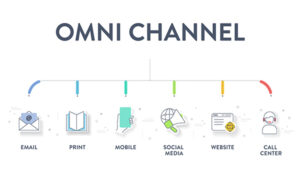Most marketers I talk to understand the importance of omnichannel experiences. B2B content strategy and digital experience leaders all get it: Our customers expect omnichannel experiences. We need to design customer journeys that engage and support them no matter how they choose to interact with our brand.
But shifting to an omnichannel strategy is no easy feat. It requires changing your organization’s fundamental approach to content creation and digital experience. It requires a whole new level of audience-centricity. You’ve got to start somewhere, though, and that’s why Tendo suggests a crawl, walk, run approach. Let’s get moving.
What Is an Omnichannel Journey and Why Does It Matter?
In an omnichannel customer journey, your users get a cohesive experience across every touchpoint and channel, from phone and chatbot to web and email. It’s not enough to offer them multiple channels (that’s called “multichannel strategy”); you must ensure that each channel is consistent and connected, with unified messaging, visual design, personalization, and functionality optimized across all.
A successful omnichannel journey or user experience should have five key qualities, according to Nielsen Norman Group:
- Consistent
- Optimized
- Seamless
- Orchestrated
- Collaborative
Delivering omnichannel experiences benefits the bottom line. According to a 2024 Forrester study, 46% of businesses that adopted an omnichannel marketing strategy saw increased customer lifetime value. That outcome makes sense, when you also consider that B2B customers now regularly use 10 or more channels to interact with a business—up from five in 2016, according to a 2021 McKinsey survey.

Barriers to Designing Omnichannel Experiences
Again, all the enterprise marketing and digital teams I work with want to be more user-focused and audience-centric. The biggest challenge to delivering omnichannel experiences is organizational silos. Here are a few ways that silos impede omnichannel strategies:
- Sales, marketing, and CX teams may develop content independently, so users get inconsistent messaging and experiences.
- Product groups may focus only on specific offerings and aren’t aware of how other departments engage with customers.
- Different digital and marketing teams may own different channels (web, social, events, etc.).
- Busy marketing teams might be immersed in getting the next campaign or product launch out the door using the channels they manage—there simply isn’t time to coordinate with other internal groups about omnichannel experiences across the customer journey.
To overcome these issues, organizational leaders can adopt a crawl, walk, run approach, starting small and building on their successes.
The Crawl Stage: Focus on Content Consistency
Begin your omnichannel journey by examining your existing content and digital touchpoints. Focus on improving consistency through the following steps:
- Create touchpoint maps to document the journeys of each persona or target audience; they should include details like the informational needs at each stage and preferred channels and devices. Touchpoint maps give you visibility into the full customer journey, beyond just the part of it that your team owns.
- Create an asset map that catalogs all the content and campaigns a persona will see along each stage in their journey. Asset maps reveal the breadth of content types, designs, and messaging variations a user will experience.
- Identify and update outdated or inconsistent branding, messaging, design, and UX functionality across channels and individual content assets.
The Walk Stage: Optimize Channels, Make Transitions Seamless
Once you’ve achieved a basic level of consistency across touchpoints and content, you’re ready to optimize and connect your channels. This “walk” stage also requires updates to your processes when creating new content.
- Audit and optimize your existing channels. Determine how effectively they are being used for a given task or context, and if they were chosen purposefully for that task. Then create a content experience that is “optimized” for the channel—like snippets of copy tailored for chatbots or visuals designed for mobile applications—while keeping consistent with the experience on other channels.
- Ensure transitions between channels and touchpoints are seamless, so users can easily pick up where they left off. Determine where a given channel connects with other channels or journey stages; then evaluate and optimize those connection points. For example, how easy is it for a user to transition from a product webpage to customer support if they need help?
- Embrace modular and structured content to optimize channels without needing to manually create bespoke experiences for each one. Modular content is the first step, in which you break content into smaller blocks or segments that can be easily adapted and reused in different ways. Structured content adds rules and metadata to make it even more efficient to repurpose and deliver content across channels.
- Optimize your taxonomy to unleash the power of structured content and dynamic content delivery (e.g., “related content”), as well as personalization in the “run” stage. A well-organized taxonomy with rich tags, categories, and other metadata is a foundational requirement for using technologies like headless CMSs and DXPs.
Real talk: The walk stage can require significant effort, especially when your organization begins to lay the groundwork for structured content and advanced personalization. Rethinking how you create content—as atomized elements that can be repurposed and recombined, depending on the channel or context—doesn’t happen overnight. And optimizing taxonomy is an ongoing process.
The Run Stage: Orchestrated Omnichannel Experiences
Once you’ve developed the ability to create consistent, optimized, and seamless omnichannel experiences, you’re ready to tackle journey orchestration. In a nutshell, you are using data to inform decisions about what personalized experiences to deliver and when. You can proactively and progressively lead customers through their journeys, serving the right content to the right audience, at the right moment.
- Scale and refine personalization to reach more specific audience segments and deliver tailored and relevant experiences.
- Leverage customer data to inform AI, which can act as a content curator for users and deliver hyper-personalized experiences. This effort builds on the taxonomy and modular/structured content groundwork laid in the “walk” stage.
Getting to the “run” stage takes work, but the fundamental processes and elements you put in place will pay dividends by making omnichannel content creation and delivery efficient and scalable. And you’ll reap the benefits of happier and more engaged customers.
Getting to Omnichannel
This blog post provides a starting framework to help your organization shift to an omnichannel approach. There’s lots more to say about designing omnichannel journeys. We’ll keep the conversation going on our blog and LinkedIn feed in the coming months. We love to share our thinking and lessons learned.
In the meantime, please don’t hesitate to reach out to us and tell us where you’re at or what you’re struggling with.









